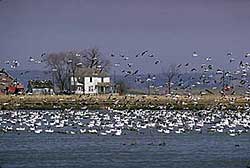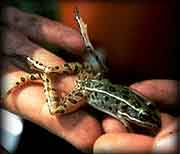Pesticides and Biodiversity
(2001)
| CONTENTS |
|
1. Introduction This site was designed to provide a brief but useful overview of the problems we face concerning pesticides and their effects on biodiversity.
Pesticides impact wildlife on many different levels, from direct to indirect lethality to non-lethal yet severely degradative. All of these have the potential to further reduce the diversity of organisms we see today.
On an economic level, some of the affected organisms are beneficial to us, including the native pollinators. On an intrinsic level, all life is worth supporting and this is the main focus behind this report.
2. The Effects of Pesticides on Biodiversity
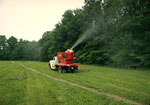 |
| Source: USDA On Line Photography Center |
A. Dispersal to Surrounding Environments
It is estimated that 70-90% of ground-applied pesticides and only 25-50% of aerially-applied pesticides actually reach their target area (*WWF, 1999). The remainder is dispelled into the environment where it exposes wildlife and people. Pesticides can enter non-agricultural landscapes in numerous ways, including direct overspray. Field margins are often sprayed directly for control of insects and weeds that might spread into the crop (Boutin et al., 1999). Indirectly, pesticides can "drift" from the site of application in numerous ways.
These include:
|
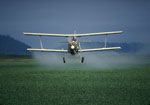  |
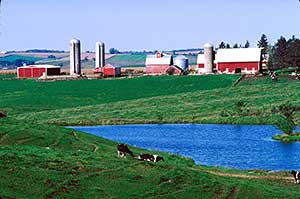 |
| Sources: USDA On Line Photography Center |
These mechanisms, together with the ability of some chemicals to persist in the environment for a number of years (*EPA) means that pesticides have the potential to affect an immense variety of wildlife, from birds feeding on infected seeds to polar bears feeding on saltwater fish hundreds of kilometers away.
B. Direct Lethal Effects
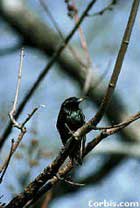 |
| Source: CORBIS |
 |
| Source:U.S. ARS |
And this is certainly worth some thought÷
According to the World Health Organization, approximately 20,000 people die as a result of direct pesticide poisoning every year! (*WWF)
C. Subacute Effects
The most striking evidence of the subacute effects pesticides can have on wildlife involves a group of chemicals called Endocrine Disrupters which cause subtle biochemical and physiological changes during the embryonic and early postnatal stages of development (Rolland et al., 1995). These persistent, bioaccumulative organohalogen compounds (like DDT and other pesticides) (Colburn & Clement, 1992) disrupt development of reproductive, immune, nervous, and endocrine systems, usually through mimicking and/or interfering with hormones (Rolland et al., 1995). Because hormones play such a vital role in orchestrating the events of early development, the fetus is the most vulnerable to these chemicals (up to 100X more sensitive than adults) (WWF, 1998). What's worse is that endocrine disrupters work at extremely low doses, as low as parts per trillion (*WWF, 1998).
|
A well-documented example of the effects of endocrine disrupters is seen in the alligator population of Lake Apopka, Florida, where a chemical accident dumped large quantities of pesticides into the lake (*WWF, 1998). A number of disturbing abnormalities were found in hatchling and juvenile alligators, including modifications in the concentrations of sex hormones and abnormal gonadal morphology and enzyme activity (Guillette et al., 1999). The effects were attributed to embryonic exposure to pesticides including dieldrin, endrin, mirex, oxychlordane and DDT (Guillette et al., 1999).
|
|
||
| Effects of endocrine disrupters have been well studied in frogs which are especially vulnerable to these compounds due to the permeability of their skin (*WWF, 1998). As well as disturbing processes in early tadpole development, accumulation of endocrine disruptors in tissue causes interference in metamorphosis (*WWF, 1998). Endocrine disrupters are blamed for grotesque deformities in frog populations. |
Other examples of the effects of endocrine disruptors:
|
Although many of these chemicals would not be considered to be directly toxic or lethal, the effects (often delayed to the next generation) are sufficient to impair populations in the following ways:
- inability to recover from infectious diseases due to immunosuppression,
- inability to obtain sufficient food, effectively avoid predators, or apply proper parenting instincts due to neurotoxicological effects, or
- develop abnormal sexual anatomy or behavior due to hormone disruption (Rolland et al., 1995).
In this way, endocrine disrupters are especially dangerous to wildlife - not only do they cause instability and increased mortality in the population, but their long-term effects severely dampen their ability to recover.
| . . . . . |
Much work has been done studying the effects of endocrine disruption because of the possibility of human impacts. However, endocrine disruption is not the only way pesticides affect organisms at a sub-lethal level. Here are some examples of subacute effects on insects:
 |
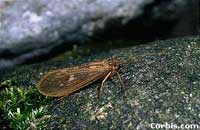 |
|
| Sources: Bee Photo - David Patriquin (Dalhousie University), Caddis Fly Photo - CORBIS | ||
- Pesticides are found to attack the nervous systems of bees in two ways. Organophosphate and carbamate pesticides inhibit an enzyme required for the proper firing of nervous impulses. Organochlorines attack directly, interfering with nerve transmission (*WWF, 1999).
- Organophosphate pesticides such as malathion, parathion and dichlorvos have numerous sub-lethal effects on Caddis flies, including: changes in net-spinning behaviour, reduction in food assimilation, and physiological deformities (*WWF, 1999).
D. Food Chain Magnification
Food chain magnification is the process by which pollutants become more concentrated as they reach higher levels of the food chain (*MC Biology).Organisms at the bottom of the food chain tend to bring into their bodies a higher concentration of the pollutant than is found in its surrounding soil or water. Some pollutants, such as DDT, resemble essential inorganic nutrients and are accidentally brought into the organism's body and stored for future use (*MC Biology).
Since the consumer at any trophic level needs to consume a lot of biomass from the lower trophic level, the consumer will ingest large quantities of the pollutant. Some pesticides, including DDT, are fat-soluble and will accumulate in the fat stores of the consumer where it will remain "available" for the consumers at the next trophic level (*MC Biology).
Some examples of food chain magnification:
|
1. High levels of DDT were found in the eggs of American Robins inhabiting Canadian apple orchards in the 1990s. It has been suggested that the route of dietary exposure was through the simple soil-earthworm-robin food chain (Harris et al., 2000). Another study involving the same food chain found an astonishing increase in DDT concentrations from 9.9 part per million (ppm) in the soil to 141 ppm in earthworms to 444 ppm in the brains of adult robins. This concentration was high enough to be toxic to some birds (*WWF, 1999). Sources: Worm Photo - Courtesy of Robert L. Bugg, University of California, Robin and Orchard Photos - CORBIS |
  |
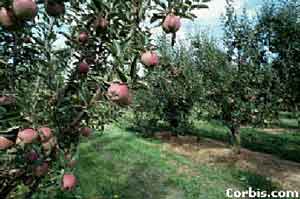 |
Although DDT has not been in use in Canada for many years, the persistence of DDT in food chains such as these is due to the slow degradation rate of the compound, its ability to accumulate in biological tissues, and its extensive use historically (Harris et al., 2000).
 |
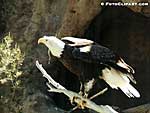 |
 |
|
| Sources: Fish and Nest Photos - USDA On Line Photography Center, Bald Eagle Photo - FOTOCLIPART | |||
2. Fish absorb and ingest high amounts of chemical contaminants from run-off into aquatic systems and are a major pathway of exposure to fish-eating birds and mammals (Colburn & Clement, 1992). Consequently, species of eagles which live in industrialized areas and depend on fish as a major food source are having difficulty reproducing (*WWF).
E. Indirect, Large Scale Effects
Indirectly, the use of herbicides and other pesticides can have drastic effects on biodiversity over a very large scale. For example, increases in chick mortality rates have been caused by increases in herbicide use. How is it that a weed-killer used on cereal crops (not directly toxic to birds, Sotherton et al., 1988) could cause these problems? The decrease in plant diversity begins a cascade of events which ultimately affects a multitude of species (Kearns & Inouye, 1997).
 |
| Source: USDA On Line Photography Center |
The extensive use of herbicides reduces the abundance of many plants, which subsequently decreases the diversity of the insects and pollinators that depend on them. Since thousands of wild plants depend on insect pollinators in order to produce seeds and fruit, this leads to a further decrease in plant diversity. This vicious circle is intensified by the use of broad-spectrum insecticides (Kearns & Inouye, 1997).
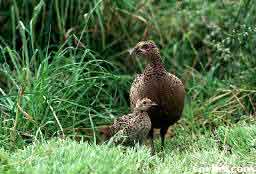 |
| Source: CORBIS |
In this way, a decrease in plant diversity from the use of herbicides affects not only organisms that consume seeds, fruit or plants, or that use plant material for nest construction, but also those that rely on insects as a food source (Kearns & Inouye, 1997). Partridge and Pheasant chicks between 2-3 weeks of age rely entirely on insects as the protein source for growth. An increase in the use of herbicides has been shown to be responsible for increased chick mortality due to lack of food (Sotherton et al., 1988; Hill, 1985).
Negative impacts on the population level can lead to problems at the community-level such as drop in biomass and diversity. These in turn may lead to "irreversible ecosystem impacts, which echo up and down the food chain at all trophic levels" (*WWF, 1999)
F. Genetically Engineered Crops
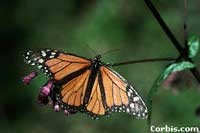 |
| Source:CORBIS |
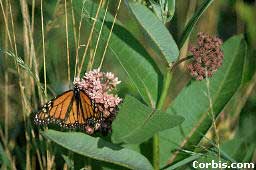 |
| Source: CORBIS |
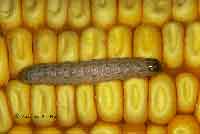 |
| Source: Courtesy of Marlin E. Rice, Iowa State University |
Other laboratory tests show negative effects of GE crops on other non-target organisms.
Some examples:
|
1. Anti-aphid toxin expressed by an experimental genetically engineered potato reduces fertility and shortens the lives of ladybugs that eat the aphids (*National Research Institute, 1997).
2. Lacewings have higher death rates when fed the larvae of target insects that have eaten Bt corn (*National Research Institute, 1997).
| ||
| Sources: U.S. ARS |
3. Some Facts and Figures
- Approximately 39,000 tons of DDT are produced each year in at least five countries, and it is imported legally into dozens more (*WWF)
- Half-lives of herbicides in the environment can range from less than 1 month to more than 1 year (Freemark & Boutin, 1995)
- We are dependent on insect pollination for one of every three bites of food we eat. Canadian crops that are wholly or partially dependent on insect pollination include apples, pears, blueberries, strawberries, raspberries, cherries, pumpkins, squash, alfalfa, clover, some types of beans, cucumbers, eggplants, melons and tomatoes (*WWF, 1999)
- Yield losses of 665 tonnes per acre in New Brunswick blueberry fields were directly related to depressed pollination from native bees, due to the spraying of fenitrothion (*WWF, 1999)
- More than 4,000 examples of resistance to insecticides have been documented in populations of about 500 species of insects (*National Research Council, 1997)
- Resistant European corn borer strains in some studies require 30-60 times more toxin to kill 50% of the test populations of young larvae compared to non-resistant European corn borer strains (*National Research Council, 1997)
- The parasitoid Banchus flavescens, which parasitizes the Bertha Armyworm, if not impacted by pesticides designed to kill Bertha Armyworm can cause pest mortality levels of up to 60% (*WWF, 1999)
- In 1996, 20,000 Swainson's hawks over-wintering in Argentina were killed by the pesticide monocrotophos (*WWF)
- In this century, several hundred billion pounds of pesticides have been produced and released into the global environment (*WWF)
 |
| Source: CORBIS |
4. Important Terms
- Bioaccumulative Chemicals
- The chemicals that remain in biological tissues (such as fat stores) and whose concentrations in the tissues increase upon subsequent exposure.
- Biodiversity
- The variety of existing life (plant, animal and microorganism) in the surrounding environment; it takes into account the number of species present, the amount of genetic variation within a species, and the habitats in which they live.
- DDT
- A persistent, bioaccumulative organochloride pesticide known to cause adverse effects to wildlife, including endocrine disruption; it has been banned in many countries but is presently being used in much of the third world.
- Drift
- The process by which pesticides can be spread from treated areas to the surrounding environment; it includes movement by air, water, and animals.
- Endocrine Disrupters
- The chemicals which cause abnormalities in development and reproduction through mimicking and/or interfering with hormones.
- Persistent Chemicals
- The chemicals whose slow rate of degradation allows them to remain in the environment for long periods of time, even years.
- Pesticide
- A chemical that is used to control the populations of undesired organisms, including bacteria, fungi, weeds, insects and rodents.
5. Useful Links
- ENVIRONMENT CANADA - CANADIAN WILDLIFE SERVICE
(http://www.cws-scf.ec.gc.ca/nwrc/pestcont.htm). Environment Canada, spons. (Rev. 22 January 1999; Viewed 24 January 2001)
Provides links to many research articles concerning agriculture and biodiversity. - U.S. ENVIRONMENTAL PROTECTION AGENCY - PESTICIDES
(http://es.epa.gov/oeca/guide/pestic.htm). U.S. Environmental Protection Agency, spons. (Rev. 26 June 1998; Viewed 24 January 2001)
Describes pesticide use and control in the U.S. Also mentions some alternatives to pesticide use. Contains a good glossary. - FINANCE AND DEVELOPMENT - MAINSTREAMING BIODIVERSITY IN AGRICULTURAL DEVELOPMENT
(http://www.worldbank.org/fandd/english/0398/articles/060398.htm). International Monetary Fund and The World Bank, spons. (Viewed 24 January 2001)
Provides an overview of pesticide use and the environment, and a discussion of the economics of pesticide use throughout the world. - LINK - VISIONARY INFORMATION SERVICE
(http://link.springer-ny.com). Springer Berlin Heidelberg, spons. (Rev. 24 November 2000; Viewed 24 January 2001)
Quick and easy access to journal articles from a variety of journals in all disciplines. - WORLD WILDLIFE FUND - AGRICULTURAL PESTICIDES
(http://www.worldwildlife.org/toxics/progareas/ap/index.htm). World Wildlife Fund, spons. (Viewed 24 January 2001)
Lots of information on toxic chemicals and their effects on wildlife, interestings facts and figures and useful publications.
6. Useful Literature
- Boutin, C., K.E. Freemark, and D.A. Kirk. 1999. Farmland birds in Southern Ontario: field use, activity patterns and vulnerability to pesticide use. Agriculture, Ecosystems and Environment 72:239-254.
- Chiverton, P.A. and N.W. Sotherton. 1991. The effects on beneficial arthropods of the exclusion of herbicides from cereal crop edges. Journal of Applied Ecology 28:1027-1039.
- deSnoo, G.R. 1997. Arable flora in sprayed and unsprayed crop edges. Agriculture, Ecosystems and Environment 66:223-230.
- Feber, R.E. et al. 1997. The effects of organic farming on pest and non-pest butterfly abundance. Agriculture, Ecosystems and Environment 64:133-139.
- Freemark, K. and C. Boutin. 1995. Impacts of agricultural herbicide use on terrestrial wildlife in temperate landscapes: a review with special reference to North America. Agriculture, Ecosystems and Environment 52:67-91.
- Guillette, L.J. et al. 1999. Serum concentration of various environmental contaminants and their relationship to sex steroid concentrations and phallus size in juvenile American Alligators. Archive of Environmental Contamination and Toxicology 36:447-455.
- Harris, M.L. et al. 2000. Transfer of DDT and metabolites from fruit orchard soils to American Robins (Turdus migratorius) twenty years after agricultural use of DDT in Canada. Archive of Environmental Contamination and Toxicology 39: 205-220.
- Moreby, S.J. and S.E. Southway. 1999. Influence od autumn applied herbicides on summer and autumn food available to birds in winter wheat fields in sounthern England. Agriculture, Ecosystems and Environment 72:285-297.
7. Useful Journals
- Agriculture, Ecosystems and Environment (http://www.elsevier.com) Elsevier Science Ltd, spons.
- Archives of Environmental Contamination and Toxicology (http://link.springer-ny.com/link/service/journals/00244/) Springer, spons.
- Ecological Bulletins (http://www.oikos.ekol.lu.se/EB.jrnl.html)
- Journal of Applied Ecology (http://www.blackwell-synergy.com/Journals/issuelist.asp?journal=jpe) Synergy and Blackwell Science, spons.
8. Cited Literature and Links
- Berenzen, N. et al. 2000. Information system for the ecotoxicological evaluation of surface water quality regarding pesticide input from agriculture. Limnology and Ecotoxicology Department - Technical University Braunsweig. http://www.tu-bs.de/institute/zoology/limnology/limnology.htm
- Boutin, C., K.E. Freemark, and D.A. Kirk. 1999. Farmland birds in Southern Ontario: field use, activity patterns and vulnerability to pesticide use. Agriculture, Ecosystems and Environment 72:239-254.
- Colborn, T. and C. Clement, eds. 1992. Chemically-Induced Alterations in Sexual and Functional Development: The Wildlife Connection. Princeton Scientific Publishing: New Jersey. http://www.worldwildlife.org/toxics/progareas/ed/con_1.htm
- ENVIRONMENT NEWS SERVICE (http://ens.lycos.com/ens/may99/1999L-05-19-04.html). Environment News Service, spons. (Posted 19 May 1999; Viewed 24 Jan. 2001).
- Freemark, K. and C. Boutin. 1995. Impacts of agricultural herbicide use on terrestrial wildlife in temperate landscapes: a review with special reference to North America. Agriculture, Ecosystems and Environment 52:67-91.
- Guillette, L.J. et al. 1999. Serum concentration of various environmental contaminants and their relationship to sex steroid concentrations and phallus size in juvenile American Alligators. Archive of Environmental Contamination and Toxicology 36:447-455. http://link.springer-ny.com
- Harris, M.L. et al. 2000. Transfer of DDT and metabolites from fruit orchard soils to American Robins (Turdus migratorius) twenty years after agricultural use of DDT in Canada. Archive of Environmental Contamination and Toxicology 39: 205-220.
http://link.springer-ny.com
- Hill, D.A. 1985. The feeding ecology and survival of pheasant chicks on arable farmland. Journal of Applied Ecology 22:645-654.
- Kearns, C.A. and D.W. Inouye. 1997. Pollinators, flowering plants, and conservation biology: much remains to be learned about pollinators and plants. BioScience 47:297-307.
- MC BIOLOGY (http://www.marietta.edu/~biol/102/ecosystem.html). Marietta College, spons. (Mod. 10 Oct. 1999; Viewed 19 Mar. 2001).
- NATIONAL RESEARCH COUNCIL - PLANT BIOTECHNOLOGY INSTITUTE (http://www.pbi.nrc.ca/bulletin/may97/concerns.html). National Research Council, spons. (Posted May 1997; Viewed 24 Jan. 2001).
- Rolland, R., M. Gilbertson and T. Colborn, eds. 1995. Environmentally induced alterations in development: a focus on wildlife.Environment Health Perspectives 103, Suppl. 4: 3-5. www.worldwildlife.org/toxics/progareas/ed/con_2.htm
- Sotherton, N.W., J.W. Dover, and M.R.W. Rands. 1988. The effects of pesticide exclusion strips on faunal populations in Great Britain . Ecological Bulletins 39:197-199.
- UNITED STATES ENVIRONMENTAL PROTECTION AGENCY - PESTICIDES (http://es.epa.gov/oeca/guide/pestic.htm). United States Environmental Protection Agency (EPA) - Office of Enforcement and Compliance Assurance (OECA), spons. (Mod. June 26, 1998; Viewed 24 Jan. 2001).
- WORLD WILDLIFE FUND - AGRICULTURAL PESTICIDES (http://www.worldwildlife.org/toxics/progareas/ap/index.htm) World Wildlife Fund, spons. (Viewed 24 Jan. 2001).
- WWF. 1999. Beneficial bugs at risk from pesticides. Site is for a printed document. Available at http://www.neteffect.ca/pesticides/resources/bugs-at-risk.pdf
Posted by Jan Oliver January 31, 2001
Modified by Jan Oliver April 14, 2001
